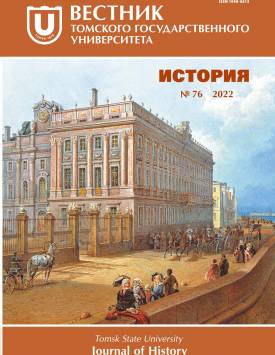The effects of natural laws in steppe Eurasia during various archaeological periods
The article is the first in the modern historical studies discussion about the impact of natural laws on historical processes in steppe Eurasia during various archaeological periods. The paper presents a historical and methodological study. The study is based on the observations collected by the author during his decades-long work on university textbooks in archaeology; archaeological sources from the Paleolithic to the Middle Ages located on the territory of the Eurasian steppe belt and mountain systems of Eurasia as well as the author’s works that consider the steppe Eurasian belt and mountain valleys as a natural basis for historical and civilizational development starting from the Paleometal age of the 4th-3rd millennium BC. Employing archaeological sources, Russian and foreign literature, the author substantiates and examines the effects of six natural and historical laws in Eurasia. The article examines in detail “the law of influence and rational use of the natural environment” known in the world science as “the law of natural determinism”, which has not become widespread in Russia due to its unreasonable application in biology, genetics, and racial theories. Supporters of the common application of this law ignored the fact that it can be applied only to nature and material culture. Biology has its own established natural laws. The other five laws are introduced for the first time. For instance, the operation of the natural law of civilizational development indicates that productive economy is the basis for the civilization process in the steppe Eurasia starting at the end of the 4th millennium BC, in the early Paleometal age, and was associated with the spread of nomadic cattle-breading in the steppe belt of Eurasia. It triggered the exploration of new territories of Eastern Europe and led to the second stage of the so-called Neolithic revolution (G. Childe). The key event was the separation of productive economy into two main lines: farming and nomadic cattle-breading as the basis for food production. The article examines the formation of state structures as an effect of natural laws, thus contradicting the established theory of the emergence of states as a result of the formation of classes and class struggle. The spread of discoveries and innovations in ancient history is considered as a basic foundation of historical development. In addition, the author opens the consideration of the natural law of ethnic leadership. Finally, the article discusses the effects of the natural historical law of the tradition transfer and preservation. The author believes that the paper is polemical since it raises a number of methodological issues of archaeology and Russian historical science in general.
Keywords
archaeology, development, natural laws, scienceAuthors
| Name | Organization | |
| Martynov Anatoly I. | Kemerovo State Institute of Culture; Kuzbass Museum-Reserve "Tomskaya Pisanitsa” | prof_martynov@mail.ru |
References

The effects of natural laws in steppe Eurasia during various archaeological periods | Tomsk State University Journal of History. 2022. № 76. DOI: 10.17223/19988613/76/23
